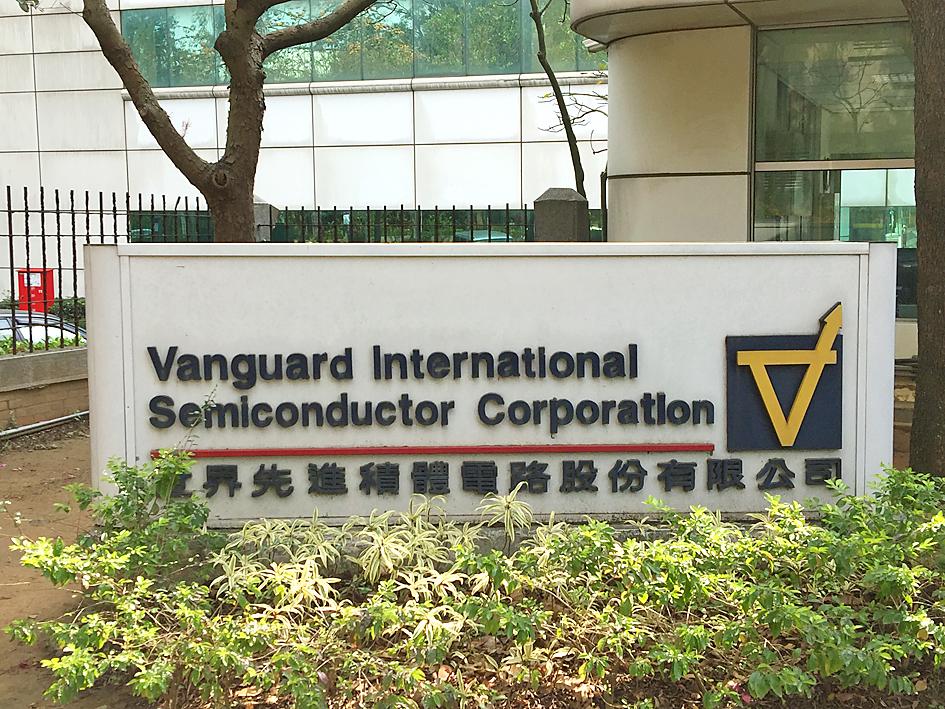Contract chipmaker Vanguard International Semiconductor Corp (世界先進) yesterday said that it plans to allocate 41.2 percent more capital expenditure to expand capacity this year as demand has greatly surpassed its capacity amid a stay-at-home trend.
The Hsinchu-based chipmaker plans to spend NT$5 billion (US$176.14 million) on new facilities and equipment to mitigate the supply crunch, up from NT$3.54 billion last year.
Based on its expenditure plan, the chipmaker’s most-requested 0.18-micron and 0.25-micron technology capacity would increase by a combined 20 percent from last year, Vanguard said.

Photo: Grace Hung, Taipei Times
Part of the spending would be to expand automotive chips, which make up less than 10 percent of its total shipments, Vanguard said.
“Demand for semiconductors is very strong this year,” Vanguard chairman Fang Leuh (方略) told investors at a teleconference. “The demand momentum is to last for two to three quarters at least before taking a pause.”
Some customers have booked orders for third-quarter shipments, Fang said.
Vanguard said that it has clear order visibility and expects factory utilization rate to remain “quite high” in the first half of this year, thanks to rising demand.
The equipment loading rate has risen to 100 percent from 95 percent last quarter, it said.
Vanguard is exploring ways to expand its 8-inch wafer capacity, including via acquisitions, as it is unable to fully satisfy demand, it said.
The company in 2019 purchased an 8-inch fab from GlobalFoundries Inc for US$236 million.
For this year, Vanguard expects shipments of power management ICs to outgrow flat-panel driver ICs.
It expects a double-digit percent annual growth rate for its power management ICs, which contributed 56 percent to the company’s revenue last quarter, Vanguard said.
As chip supply tightens, Vanguard has hiked prices for new orders by about 5 percent this quarter, due to higher manufacturing costs, it said.
Revenue is to climb to a new high of NT$8.9 billion to NT$9.3 billion this quarter, which would be quarterly growth of 2.06 to 6.76 percent from NT$8.72 billion last quarter, it said.
Gross margin is to remain between 36.5 and 38.5 percent this quarter, compared with 37.4 percent last quarter, it said.
The company’s goal is to lift its gross margin to 40 percent, Vanguard said, without providing a timeframe.
Net profit last quarter jumped 21.6 percent to NT$1.82 billion, compared with NT$1.5 billion in the same period of 2019.
Last year as a whole, net profit rose 7.6 percent to NT$6.31 billion from NT$5.87 billion in 2019, or earnings per share of NT$3.81, up from NT$3.54 a year earlier.
The firm’s board of directors on Monday approved a cash dividend distribution of NT$3.5 per common share, representing a payout ratio of 92 percent.

TAKING STOCK: A Taiwanese cookware firm in Vietnam urged customers to assess inventory or place orders early so shipments can reach the US while tariffs are paused Taiwanese businesses in Vietnam are exploring alternatives after the White House imposed a 46 percent import duty on Vietnamese goods, following US President Donald Trump’s announcement of “reciprocal” tariffs on the US’ trading partners. Lo Shih-liang (羅世良), chairman of Brico Industry Co (裕茂工業), a Taiwanese company that manufactures cast iron cookware and stove components in Vietnam, said that more than 40 percent of his business was tied to the US market, describing the constant US policy shifts as an emotional roller coaster. “I work during the day and stay up all night watching the news. I’ve been following US news until 3am

UNCERTAINTY: Innolux activated a stringent supply chain management mechanism, as it did during the COVID-19 pandemic, to ensure optimal inventory levels for customers Flat-panel display makers AUO Corp (友達) and Innolux Corp (群創) yesterday said that about 12 to 20 percent of their display business is at risk of potential US tariffs and that they would relocate production or shipment destinations to mitigate the levies’ effects. US tariffs would have a direct impact of US$200 million on AUO’s revenue, company chairman Paul Peng (彭雙浪) told reporters on the sidelines of the Touch Taiwan trade show in Taipei yesterday. That would make up about 12 percent of the company’s overall revenue. To cope with the tariff uncertainty, AUO plans to allocate its production to manufacturing facilities in

Six years ago, LVMH’s billionaire CEO Bernard Arnault and US President Donald Trump cut the blue ribbon on a factory in rural Texas that would make designer handbags for Louis Vuitton, one of the world’s best-known luxury brands. However, since the high-profile opening, the factory has faced a host of problems limiting production, 11 former Louis Vuitton employees said. The site has consistently ranked among the worst-performing for Louis Vuitton globally, “significantly” underperforming other facilities, said three former Louis Vuitton workers and a senior industry source, who cited internal rankings shared with staff. The plant’s problems — which have not

COLLABORATION: Given Taiwan’s key position in global supply chains, the US firm is discussing strategies with local partners and clients to deal with global uncertainties Advanced Micro Devices Inc (AMD) yesterday said it is meeting with local ecosystem partners, including Taiwan Semiconductor Manufacturing Co (TSMC, 台積電), to discuss strategies, including long-term manufacturing, to navigate uncertainties such as US tariffs, as Taiwan occupies an important position in global supply chains. AMD chief executive officer Lisa Su (蘇姿丰) told reporters that Taiwan is an important part of the chip designer’s ecosystem and she is discussing with partners and customers in Taiwan to forge strong collaborations on different areas during this critical period. AMD has just become the first artificial-intelligence (AI) server chip customer of TSMC to utilize its advanced